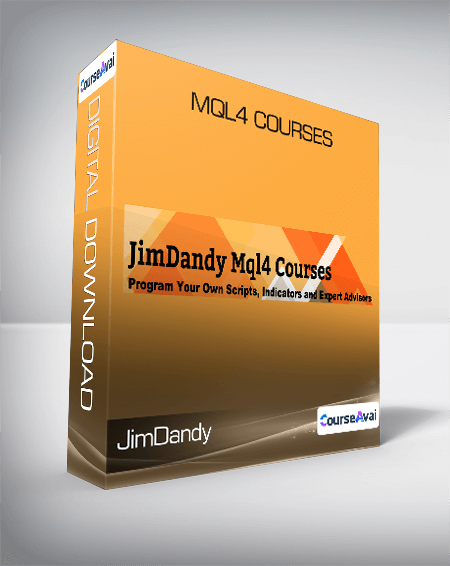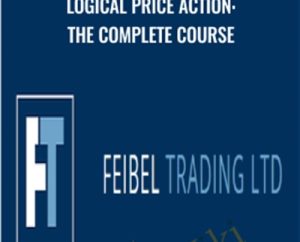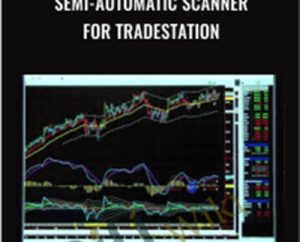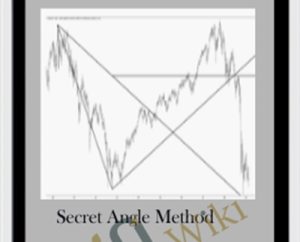Master Forex trading with the Master Forex trading with the JimDandy - Mql4 CoursesJimDandy - Mql4 Courses course, available for just course, available for just Original price was: $247.00.Original price was: $247.00.$$43.0043.00Current price is: $43.00.Current price is: $43.00. on on GripForex.comGripForex.com! Specializing in financial markets, we offer premium downloadable Forex courses in ! Specializing in financial markets, we offer premium downloadable Forex courses in Forex and TradingForex and Trading. Learn strategies from experts, trade smarter, and save over 80%. Get a grip on your trading future!. Learn strategies from experts, trade smarter, and save over 80%. Get a grip on your trading future!
Salepage link: Salepage link: At HERE. Archive:
JimDandy – Mql4 Courses
Module 1
| Module 1Module 1 | The BasicsThe Basics |
| Unit 1Unit 1 | A Look Around the “New” MetaEditorA Look Around the “New” MetaEditor |
| Unit 2Unit 2 | Precompiler Lines and the FrameWork of Our CodePrecompiler Lines and the FrameWork of Our Code |
| Module 2Module 2 | 610 Functions Explained and the Debugger610 Functions Explained and the Debugger |
| Unit 1Unit 1 | How a Function is WrittenHow a Function is Written |
| Unit 2Unit 2 | Calling a FunctionCalling a Function |
| Unit 3Unit 3 | DebuggerDebugger |
| Module 3Module 3 | 610 Variables and Data Types610 Variables and Data Types |
| Unit 1Unit 1 | Variables and Data TypesVariables and Data Types |
| Unit 2Unit 2 | Integers, Bytes, Bits? How a Computer Stores NumbersIntegers, Bytes, Bits? How a Computer Stores Numbers |
| Unit 3Unit 3 | Keeping Time With DateTime and OnTimer()Keeping Time With DateTime and OnTimer() |
| Unit 4Unit 4 | Working With the Color Integer Data TypeWorking With the Color Integer Data Type |
| Unit 5Unit 5 | Creating Our Own Integer Data Types with EnumerationsCreating Our Own Integer Data Types with Enumerations |
| Unit 6Unit 6 | Boolean Type IntegersBoolean Type Integers |
| Unit 7Unit 7 | Floats,Doubles and StringsFloats,Doubles and Strings |
| Unit 8Unit 8 | Global Scope, Local Scope and Static VariablesGlobal Scope, Local Scope and Static Variables |
| Unit 9Unit 9 | Extern or Input?Extern or Input? |
| Module 4Module 4 | OperationsOperations |
| Unit 1Unit 1 | Arithmetic OperationsArithmetic Operations |
| Unit 2Unit 2 | Assignment OperationsAssignment Operations |
| Unit 3Unit 3 | Relation OperationsRelation Operations |
| Unit 4Unit 4 | Boolean OperationsBoolean Operations |
| Unit 5Unit 5 | Ternary OperatorTernary Operator |
| Unit 6Unit 6 | Switch OperatorSwitch Operator |
| Unit 7Unit 7 | While and Do While Loop OperatorsWhile and Do While Loop Operators |
| Unit 8Unit 8 | For Loop OperatorFor Loop Operator |
| Module 5Module 5 | Object Oriented Programming Basics: Structures and Classes.Object Oriented Programming Basics: Structures and Classes. |
| Unit 1Unit 1 | StructuresStructures |
| Unit 2Unit 2 | Structures…Classes…Necessary?Structures…Classes…Necessary? |
| Unit 3Unit 3 | ConstructorsConstructors |
| Unit 4Unit 4 | DestructorsDestructors |
| Unit 5Unit 5 | Classes, Setters and GettersClasses, Setters and Getters |
| Unit 6Unit 6 | Encapsulation, Extensibility, Overloading, PolyMorphism?Encapsulation, Extensibility, Overloading, PolyMorphism? |
| Unit 7Unit 7 | Using the Mql4 Wizard to Create a ClassUsing the Mql4 Wizard to Create a Class |
| Unit 8Unit 8 | InheritanceInheritance |
| Unit 9Unit 9 | OOP Conclusion and CommentaryOOP Conclusion and Commentary |
Module 2
| Module 1Module 1 | So What’s a Script and How Do We Make One?So What’s a Script and How Do We Make One? |
| Unit 1Unit 1 | What is a Script?What is a Script? |
| Unit 2Unit 2 | Daily Range ScriptDaily Range Script |
| Module 2Module 2 | MessageBox A Useful ToolMessageBox A Useful Tool |
| Unit 1Unit 1 | Introduction to MessageBoxIntroduction to MessageBox |
| Unit 2Unit 2 | Message Box FlagsMessage Box Flags |
| Unit 3Unit 3 | #Defines and the Hexadecimal System#Defines and the Hexadecimal System |
| Unit 4Unit 4 | Using MessageBox to Choose Our PathUsing MessageBox to Choose Our Path |
| Module 3Module 3 | Getting Our Attention with Email and Push NotificationsGetting Our Attention with Email and Push Notifications |
| Unit 1Unit 1 | Sounding an AlertSounding an Alert |
| Unit 2Unit 2 | Email and Push NotificationsEmail and Push Notifications |
| Module 4Module 4 | Knowledge Is Power (Gathering Information)Knowledge Is Power (Gathering Information) |
| Unit 1Unit 1 | Gathering Information Using Pre Defined Variables.Gathering Information Using Pre Defined Variables. |
| Unit 2Unit 2 | MarketInfo() Function Part1MarketInfo() Function Part1 |
| Unit 3Unit 3 | MarketInfoFunction() Part2MarketInfoFunction() Part2 |
| Unit 4Unit 4 | AccountInfoAccountInfo |
| Module 5Module 5 | Order Management Using ScriptsOrder Management Using Scripts |
| Unit 1Unit 1 | Sending Orders With ScriptsSending Orders With Scripts |
| Unit 2Unit 2 | Selecting an Order For ModificationSelecting an Order For Modification |
| Unit 3Unit 3 | Error Checking in Our CodeError Checking in Our Code |
| Unit 4Unit 4 | Placing Pending OrdersPlacing Pending Orders |
| Unit 5Unit 5 | Buying/Selling Scripts and Point/Pip Explained.Buying/Selling Scripts and Point/Pip Explained. |
| Unit 6Unit 6 | Drag And Drop ScriptsDrag And Drop Scripts |
| Unit 7Unit 7 | Deleting Pending OrdersDeleting Pending Orders |
| Unit 8Unit 8 | Using a For Loop to Delete OrdersUsing a For Loop to Delete Orders |
| Unit 9Unit 9 | Closing Market Orders (Trades)Closing Market Orders (Trades) |
Module 3
| Module 1Module 1 | Indicators And The Arrays That Make Them PossibleIndicators And The Arrays That Make Them Possible |
| Unit 1Unit 1 | Custom Indicator IntroductionCustom Indicator Introduction |
| Unit 2Unit 2 | The Simplest Indicator and Where It Comes FromThe Simplest Indicator and Where It Comes From |
| Unit 3Unit 3 | Series ArraysSeries Arrays |
| Unit 4Unit 4 | Array Functions ExplainedArray Functions Explained |
| Module 2Module 2 | How To Write the Code For an IndicatorHow To Write the Code For an Indicator |
| Unit 1Unit 1 | How Indicators Become Part of the Chart.How Indicators Become Part of the Chart. |
| Unit 2Unit 2 | Making the Indicator Display at a Specific Place On the Chart.Making the Indicator Display at a Specific Place On the Chart. |
| Unit 3Unit 3 | The New OnCalculate FunctionThe New OnCalculate Function |
| Unit 4Unit 4 | Drawing With Loops and Array Out of RangeDrawing With Loops and Array Out of Range |
| Unit 5Unit 5 | Putting Logic Into Our IndicatorPutting Logic Into Our Indicator |
| Module 3Module 3 | Moving our Indicator to a Separate WindowMoving our Indicator to a Separate Window |
| Unit 1Unit 1 | Putting An Indicator in a Separate WindowPutting An Indicator in a Separate Window |
| Unit 2Unit 2 | Setting Properties During OnInit Instead of Using Pre-Compiler Lines.Setting Properties During OnInit Instead of Using Pre-Compiler Lines. |
| Module 4Module 4 | Working With Technical IndicatorsWorking With Technical Indicators |
| Unit 1Unit 1 | Technical Indicators Save A Lot of CodingTechnical Indicators Save A Lot of Coding |
| Unit 2Unit 2 | Let’s Make an MALet’s Make an MA |
| Unit 3Unit 3 | Setting up MaCross GraphicsSetting up MaCross Graphics |
| Unit 4Unit 4 | Setting Up MaCross LogicSetting Up MaCross Logic |
| Module 5Module 5 | Putting Controls in Our IndicatorsPutting Controls in Our Indicators |
| Unit 1Unit 1 | Putting Settings In Our MA Cross SignalPutting Settings In Our MA Cross Signal |
| Unit 2Unit 2 | Bollinger Band SignalsBollinger Band Signals |
| Unit 3Unit 3 | Fixing Array Out of Range Part 1Fixing Array Out of Range Part 1 |
| Unit 4Unit 4 | Fixing Array Out of Range Part 2Fixing Array Out of Range Part 2 |
| Unit 5Unit 5 | Putting in the NotificationsPutting in the Notifications |
| Module 6Module 6 | Combining Indicators into One SignalCombining Indicators into One Signal |
| Unit 1Unit 1 | Bollinger Stochastic Combo Part 1Bollinger Stochastic Combo Part 1 |
| Unit 2Unit 2 | Bollinger Stochastic Combo Part 2Bollinger Stochastic Combo Part 2 |
| Module 7Module 7 | How To Call a Custom IndicatorHow To Call a Custom Indicator |
| Unit 1Unit 1 | Calling Custom Indicators Part 1Calling Custom Indicators Part 1 |
| Unit 2Unit 2 | Calling Custom Indicators Part 2Calling Custom Indicators Part 2 |
| Unit 3Unit 3 | Calling Custom Indicators Part 3Calling Custom Indicators Part 3 |
| Module 8Module 8 | Special Multi-Colored Full Adjustable Macd IndicatorSpecial Multi-Colored Full Adjustable Macd Indicator |
| Unit 1Unit 1 | Our Oscillator Part 1Our Oscillator Part 1 |
| Unit 2Unit 2 | Our Oscillator Part 2Our Oscillator Part 2 |
| Unit 3Unit 3 | Our Oscillator Part 3Our Oscillator Part 3 |
| Unit 4Unit 4 | Our Oscillator Part 4Our Oscillator Part 4 |
Module 4
| Module 1Module 1 | Making it Idiot Proof and Controlling AccessMaking it Idiot Proof and Controlling Access |
| Unit 1Unit 1 | Starting From the BeginningStarting From the Beginning |
| Unit 2Unit 2 | Checking Our SettingsChecking Our Settings |
| Unit 3Unit 3 | Password ProtectionPassword Protection |
| Unit 4Unit 4 | Your Expert Can Close Itself!Your Expert Can Close Itself! |
| Unit 5Unit 5 | Code that will expire.Code that will expire. |
| Module 2Module 2 | The Basic FoundationThe Basic Foundation |
| Unit 1Unit 1 | The Mandatory Components of a Basic EAThe Mandatory Components of a Basic EA |
| Unit 2Unit 2 | Reviewing The Basic ComponentsReviewing The Basic Components |
| Module 3Module 3 | Using iCustom To Call Your IndicatorUsing iCustom To Call Your Indicator |
| Unit 1Unit 1 | How to Call a Custom Indicator With iCustom()How to Call a Custom Indicator With iCustom() |
| Unit 2Unit 2 | Calling With Custom ParametersCalling With Custom Parameters |
| Unit 3Unit 3 | Multiple TimeFrame ProblemsMultiple TimeFrame Problems |
| Unit 4Unit 4 | Custom Indicator Calling Tool and DEMA EACustom Indicator Calling Tool and DEMA EA |
| Unit 5Unit 5 | Practice Your Trigger CodingPractice Your Trigger Coding |
| Module 4Module 4 | Adding More Functionality to Our Basic EAAdding More Functionality to Our Basic EA |
| Unit 1Unit 1 | Auto-Generating Our MagicNumbersAuto-Generating Our MagicNumbers |
| Unit 2Unit 2 | Adding Move to BreakEvenAdding Move to BreakEven |
| Unit 3Unit 3 | Adding a Trailing StopAdding a Trailing Stop |
| Unit 4Unit 4 | Adding a Candle (Swing High/Low) StopAdding a Candle (Swing High/Low) Stop |
| Unit 5Unit 5 | Solving Stoploss Coding ProblemsSolving Stoploss Coding Problems |
| Unit 6Unit 6 | Moving Indicator Code Into Our Expert AdvisorMoving Indicator Code Into Our Expert Advisor |
| Module 5Module 5 | Controlling the Opening and Closing Of TradesControlling the Opening and Closing Of Trades |
| Unit 1Unit 1 | Limiting Number of Orders and Checking if Hedging is AllowedLimiting Number of Orders and Checking if Hedging is Allowed |
| Unit 2Unit 2 | Closing On Opposite SignalClosing On Opposite Signal |
| Unit 3Unit 3 | Closing Trades On a FIFO Compliant PlatformClosing Trades On a FIFO Compliant Platform |
| Module 6Module 6 | Martingaling The Two-Edged SwordMartingaling The Two-Edged Sword |
| Unit 1Unit 1 | MartingalingMartingaling |
| Unit 2Unit 2 | Market Trapper Part 1Market Trapper Part 1 |
| Unit 3Unit 3 | Market Trapper Part2Market Trapper Part2 |
| Module 7Module 7 | Controlling a Sequence of TradesControlling a Sequence of Trades |
| Unit 1Unit 1 | Using Trade Comments to Identify TradesUsing Trade Comments to Identify Trades |
| Unit 2Unit 2 | Knowing When to Quit TradingKnowing When to Quit Trading |
| Unit 3Unit 3 | An OnScreen Display to Monitor Our SituationAn OnScreen Display to Monitor Our Situation |
| Unit 4Unit 4 | Setting Lotsize For Each Trade in The Sequence.Setting Lotsize For Each Trade in The Sequence. |
| Module 8Module 8 | Basket TradingBasket Trading |
| Unit 1Unit 1 | Introducing Basket TradingIntroducing Basket Trading |
| Unit 2Unit 2 | Coding a MACD TriggerCoding a MACD Trigger |
| Unit 3Unit 3 | Controlling our Trade SpacingControlling our Trade Spacing |
| Unit 4Unit 4 | The Math of “Cost Averaging”The Math of “Cost Averaging” |
| Unit 5Unit 5 | Closing All Trades TogetherClosing All Trades Together |
| Unit 6Unit 6 | Using a Auto-Mild MartingaleUsing a Auto-Mild Martingale |
| Unit 7Unit 7 | Manual MartingaleManual Martingale |
| Unit 8Unit 8 | BasketTrader SmartingaleBasketTrader Smartingale |
| Unit 9Unit 9 | Displaying the Basket BreakevenDisplaying the Basket Breakeven |
| Unit 10Unit 10 | Basket Trader Finished.Basket Trader Finished. |
| Unit 11Unit 11 | Concluding RemarksConcluding Remarks |
Strengthen your trading skills with the Strengthen your trading skills with the JimDandy - Mql4 CoursesJimDandy - Mql4 Courses course at course at GripForex.comGripForex.com! Gain lifetime access to expert-led Forex content, designed to enhance your market understanding and profitability.! Gain lifetime access to expert-led Forex content, designed to enhance your market understanding and profitability.
- Lifetime Access:Lifetime Access: Unlimited, permanent access to your Forex trading courses. Unlimited, permanent access to your Forex trading courses.
- Significant Savings:Significant Savings: Enjoy prices up to 80% lower than retail. Enjoy prices up to 80% lower than retail.
- Secure Transactions:Secure Transactions: Your financial details are protected during payment. Your financial details are protected during payment.
- Practical Trading Skills:Practical Trading Skills: Acquire actionable strategies for real-world Forex markets. Acquire actionable strategies for real-world Forex markets.
- Instant Access:Instant Access: Begin your trading education immediately after purchase. Begin your trading education immediately after purchase.
- Learn Anywhere:Learn Anywhere: Access your Forex courses on any device. Access your Forex courses on any device.
Take control of your trading with GripForex.com!Take control of your trading with GripForex.com!
Additional information
| Status | Available |
|---|
Only logged in customers who have purchased this product may leave a review.












Reviews
There are no reviews yet.